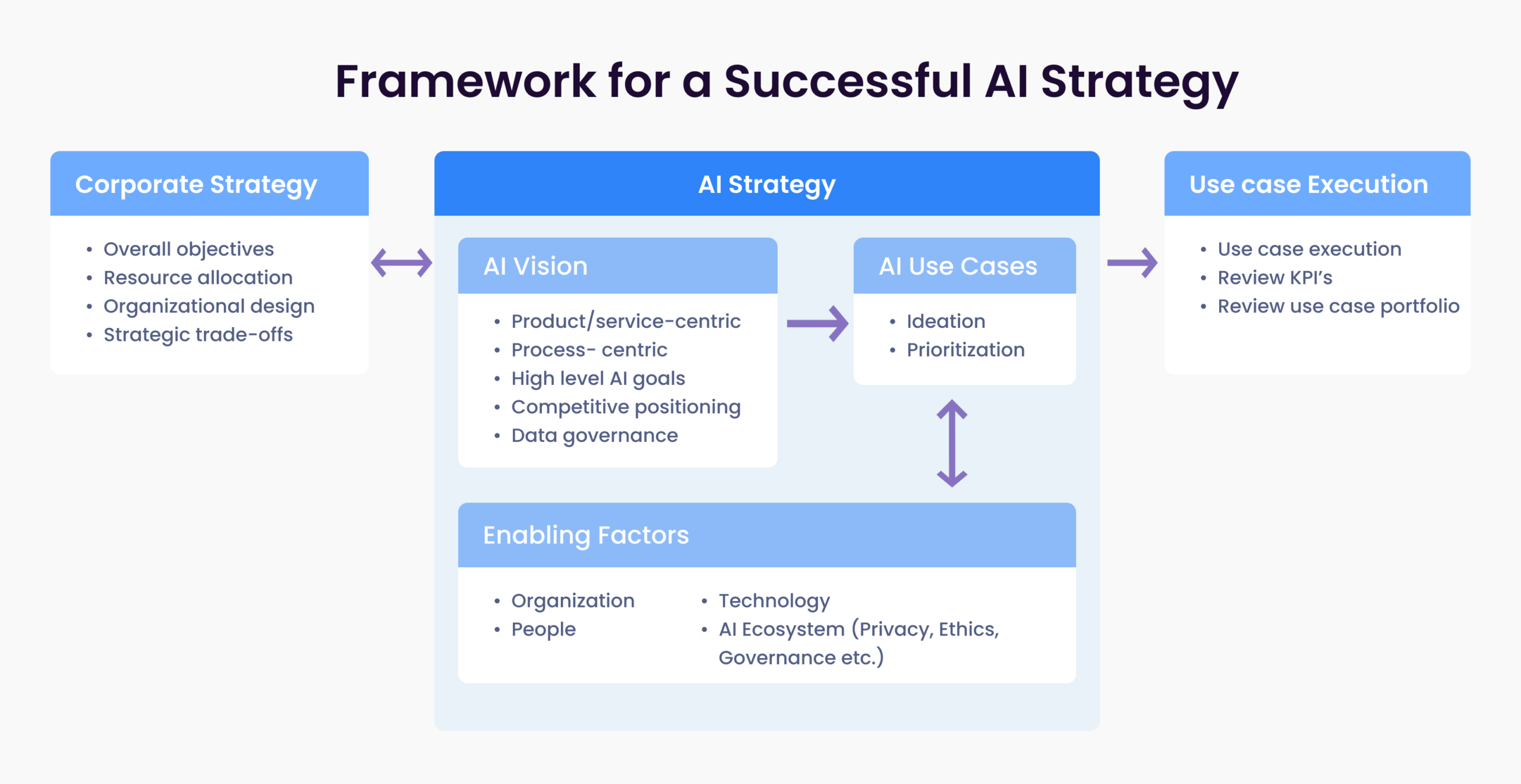Artificial Intelligence, AI, has the potential to transform businesses, just like the internet has done for the way business is done. AI can help businesses improve and optimize processes, enhance productivity, and their customer experiences. Systematically, enterprises can leverage AI in existing products/services, develop new AI-driven products/services, or redesign internal processes.
Businesses that are unable to capitalize on this AI’s transformative power may be left behind. Hence, creating an AI strategy becomes imminent and unavoidable.
Common Challenges of AI Applications
Before implementing AI, organizations need to understand its various capabilities and limitations. A few common pitfalls can be identified in AI applications.
- Many companies start implementing AI use cases without clearly defining their goals and to what extent and how they will use AI to achieve them. Doing so often leads to the development of isolated AI use cases that do not produce value for their business.
- Scaling up pilot projects can be hard for most companies. The development of pilot use cases is typically easier compared to the actual deployment of production-scale projects.
- Many organizations lack the technical expertise and resources to implement AI use cases. For instance, non-IT companies typically lack the necessary infrastructure and talent to develop AI use cases internally. The lack of these capabilities can create a vicious circle if an organization decides to invest in AI or data infrastructure without thoroughly understanding the requirements of the use cases.
- Each use case must be carefully monitored, analyzed, and maintained to avoid repeating the same mistakes. The first step in an AI project is an evaluation. This step helps gather enough data from the first model on how to improve the model, the requirement of additional data, a better model, etc. This process is repeated continuously even when the model is in the production phase. Implementing use cases without a clear and solid maintenance strategy could risk the entire goal.
Core Components of AI Strategy
While no AI strategy is the same, all AI strategies have the same core components. These components are typically focused on data, AI infrastructure, skills, organization, and Ethics.
Data
Data is the key component of any AI strategy. This data can be anything, for instance, the sensory data of an autonomous vehicle to financial data to the feedback of customers on social media platforms. Thus, creating a data strategy that touches and addresses the “what data”, “how much”, and “how-to acquire” becomes the vital part of any AI strategy.
Infrastructure
AI has plenty of advantages, but without proper infrastructure, it is useless. The support of well-functioning data and infrastructure go into making AI a successful technology. A good infrastructure is necessary to enable an AI-capable team to perform their tasks efficiently. It should also offer the necessary computing power to handle the data that they need to ingest. Whether to opt for a unified data warehouse or to use cloud services or on-premise solutions depends on the organization’s needs.
Skill
People are at the core of any AI strategy and are responsible for all of the systems and algorithms that will be used to generate business value. Continuous efforts have to be made to empower and educate management and employees (in-house or outsourced) about AI.
Organization
Another important component of the AI strategy is to prepare the organization for AI. Coordinate with the people who are responsible for the design, development, and implementation processes and align them with the best practices on enabling AI teams to provide business values and making the processes ML-ready.
Ethics
Though not necessarily a core component of an AI strategy, the use of AI may raise potential ethical issues like incorrect insights, inherent biases, and increased unemployment due to the substitution of manpower with machines. AI enables organizations to capture the sensitive information and personal data of individuals. The temptation of the organizations to extract additional information from the data may lead the organization to overstep the ethical boundaries. Hence, the need for a responsible AI is set to increase.
Framework for a successful AI strategy
A three-step approach can be adopted for an AI strategy to succeed. The first step in applying for AI is to make sure that the company’s goals and objectives are clearly stated. There have been cases where companies have tried adopting AI projects that did not support the company’s overall purpose. Doing so could result in the project not being economically feasible. Instead of focusing solely on technology, implementing AI should also be focused on increasing the company’s bottom line.
The next step is to set up the AI vision which specifies the scope and goals of all the AI applications. The organization’s AI vision should align with the overall corporate strategy discussed in the first step along with identifying relevant use cases and certain enabling factors. Having this framework in place will help the executives keep track of the AI’s progress and provide them with clear goals.
The third and final step is to execute and implement AI across the organization. The organization should develop a strategy for how it will implement AI projects along with the steps it will take to monitor and manage the project’s operations.

Due to the complexity of AI, the strategy for its development needs to be different from that of a regular technology strategy. It should be built on a foundation of strong ethical principles and a robust technology infrastructure. If you resonate with our article and are interested in implementing AI in your organization without any major hurdles, do contact us.






